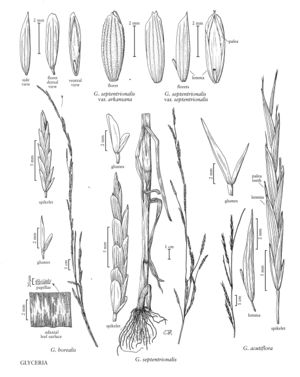Difference between revisions of "Glyceria septentrionalis var. septentrionalis"
FNA>Volume Importer |
imported>Volume Importer |
||
| (5 intermediate revisions by 2 users not shown) | |||
| Line 1: | Line 1: | ||
{{Treatment/ID | {{Treatment/ID | ||
|accepted_name=Glyceria septentrionalis var. septentrionalis | |accepted_name=Glyceria septentrionalis var. septentrionalis | ||
| − | |accepted_authority= | + | |accepted_authority= |
|publications= | |publications= | ||
|basionyms= | |basionyms= | ||
| Line 15: | Line 15: | ||
-->{{Treatment/Body | -->{{Treatment/Body | ||
| − | |discussion=<p><i>Glyceria septentrionalis </i>var.<i> septentrionalis</i> grows throughout the range of the species, but is less common in the lower floodplain of the Mississippi River and Kentucky than < | + | |discussion=<p><i>Glyceria septentrionalis </i>var.<i> septentrionalis</i> grows throughout the range of the species, but is less common in the lower floodplain of the Mississippi River and Kentucky than <i></i>var.<i> arkansana</i>. It is found in shallow water or wet soils. In reviewing specimens for this treatment, some were found to have acute lemmas that usually exceeded the paleas, and lemma midveins that were clearly longer than the other veins; others had truncate to obtuse lemmas that were usually shorter than or equaling the paleas, and lemma midveins that were barely longer than the lateral veins. Further study is needed to determine whether the two kinds merit separate recognition.</p> |
|tables= | |tables= | ||
|references= | |references= | ||
| Line 24: | Line 24: | ||
-->{{#Taxon: | -->{{#Taxon: | ||
name=Glyceria septentrionalis var. septentrionalis | name=Glyceria septentrionalis var. septentrionalis | ||
| − | + | |authority= | |
| − | |authority= | ||
|rank=variety | |rank=variety | ||
|parent rank=species | |parent rank=species | ||
| Line 31: | Line 30: | ||
|basionyms= | |basionyms= | ||
|family=Poaceae | |family=Poaceae | ||
| + | |illustrator=Cindy Roché | ||
| + | |illustration copyright=Utah State University | ||
|reference=None | |reference=None | ||
|publication title= | |publication title= | ||
|publication year= | |publication year= | ||
|special status= | |special status= | ||
| − | |source xml=https:// | + | |source xml=https://bitbucket.org/aafc-mbb/fna-data-curation/src/200273ad09963decb8fc72550212de541d86569d/coarse_grained_fna_xml/V24/V24_97.xml |
|subfamily=Poaceae subfam. Pooideae | |subfamily=Poaceae subfam. Pooideae | ||
|tribe=Poaceae tribe Meliceae | |tribe=Poaceae tribe Meliceae | ||
Latest revision as of 17:26, 11 May 2021
Ligules 5-10 mm; blades 2-15 mm wide. Panicle branches 3-17 cm, with 1-9 spikelets. Rachilla internodes 1.1-1.8 mm. Lemmas scabrous over the veins, prickles about 0.05 mm, scabrous or scabridulous between the veins, apices almost truncate to obtuse or acute, apical margins crenate to entire. 2n = 40.
Discussion
Glyceria septentrionalis var. septentrionalis grows throughout the range of the species, but is less common in the lower floodplain of the Mississippi River and Kentucky than var. arkansana. It is found in shallow water or wet soils. In reviewing specimens for this treatment, some were found to have acute lemmas that usually exceeded the paleas, and lemma midveins that were clearly longer than the other veins; others had truncate to obtuse lemmas that were usually shorter than or equaling the paleas, and lemma midveins that were barely longer than the lateral veins. Further study is needed to determine whether the two kinds merit separate recognition.
Selected References
None.
